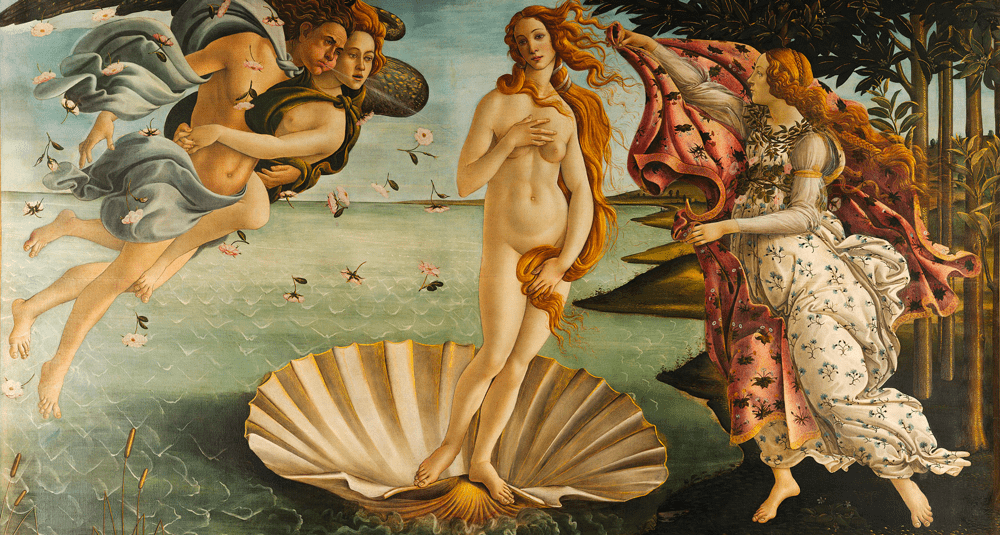Which major work by Sandro Botticelli is exhibited in the Uffizi Gallery?
Last Updated:
The Birth of Venus, painted by Sandro Botticelli around 1485, is one of the most emblematic works of the Italian Renaissance. The painting, which depicts the goddess Venus emerging from the waves on a shell, is displayed in the famous Uffizi Gallery in Florence, Italy. It symbolizes not only divine beauty, but also the artistic and cultural renewal that characterized this period in art history.
Botticelli created The Birth of Venus for the wealthy Medici family, who played a central role in the patronage of the Florentine Renaissance. The Medici were great art collectors and supported the greatest artists of their time, including Botticelli. The painting is said to have been commissioned by Lorenzo di Pierfrancesco de’ Medici, a distant cousin of Lorenzo the Magnificent, head of the Medici family.
The mythological theme of the work is inspired by classical tales, in particular the writings of the poet Hesiod. According to Greek mythology, Venus (or Aphrodite in the Greek version) was born from the foam of the sea after the titan Cronos had cut off the genitals of Ouranos (the sky) and thrown them into the ocean. From this unlikely union was born the goddess of love and beauty. In Botticelli’s painting, Venus is seen standing on a large shell floating on the sea, pushed by Zephyr, the wind god, accompanied by Chloris. To the right, a nymph waits to clothe Venus in a mantle embroidered with flowers.
The work is distinguished by its elegant composition and soft color palette, typical of Botticelli’s style. The Birth of Venus is an example of how Renaissance art drew inspiration from both ancient culture and Christian ideals. The central figure of Venus, with her golden hair and delicate skin, represents an idealized form of feminine beauty, often associated with purity and divine perfection. In contrast to medieval standards, where artistic representations were often rigid and symbolic, Botticelli adopts a more fluid, realistic approach here, although Venus’s body is slightly elongated and stylized.
The use of linear perspective and soft light lends the scene an ethereal, almost timeless atmosphere. The graceful movements of the figures and natural elements, such as waves and wind, reinforce this impression of lightness and fluidity. Attention to detail, particularly in the folds of Venus’ clothing and the texture of her hair, demonstrates Botticelli’s technical virtuosity.
The Birth of Venus is a celebration of divine love and ideal beauty, themes dear to the Neoplatonic thought that dominated Florentine philosophy at the time. According to this philosophy, physical love and earthly beauty were seen as reflections of divine and spiritual beauty. Botticelli’s painting can therefore be interpreted as an allegory of transcendent beauty and cosmic harmony.
Some art historians also suggest that the work represents a synthesis of pagan mythology and Christian theology. Venus, the goddess of love, could symbolize Mary, the mother of Jesus, representing a transition between classical ideals and medieval religious beliefs.
The Birth of Venus has become one of the most recognized and admired works in the history of Western art. It is a perfect illustration of the Renaissance’s rediscovery of classical antiquity, and testifies to Botticelli’s ability to combine mythological elements with an innovative artistic style. Its influence was immense, not only for Botticelli’s contemporaries, but also for subsequent generations of artists.
Today, The Birth of Venus is one of the centerpieces of the Uffizi Gallery collection in Florence, attracting millions of visitors every year. It embodies both the artistic splendor of the Renaissance and the enduring fascination with myth and divine beauty.
This work, along with Spring (also by Botticelli), continues to fascinate art lovers, symbolizing Florence’s artistic revival and the importance of Medici patronage in the development of Renaissance art.
arts

Which major work by Sandro Botticelli is exhibited in the Uffizi Gallery?
Answer
The Birth of Venus is one of Sandro Botticelli's major works, exhibited at the Uffizi Gallery in Florence, Italy.